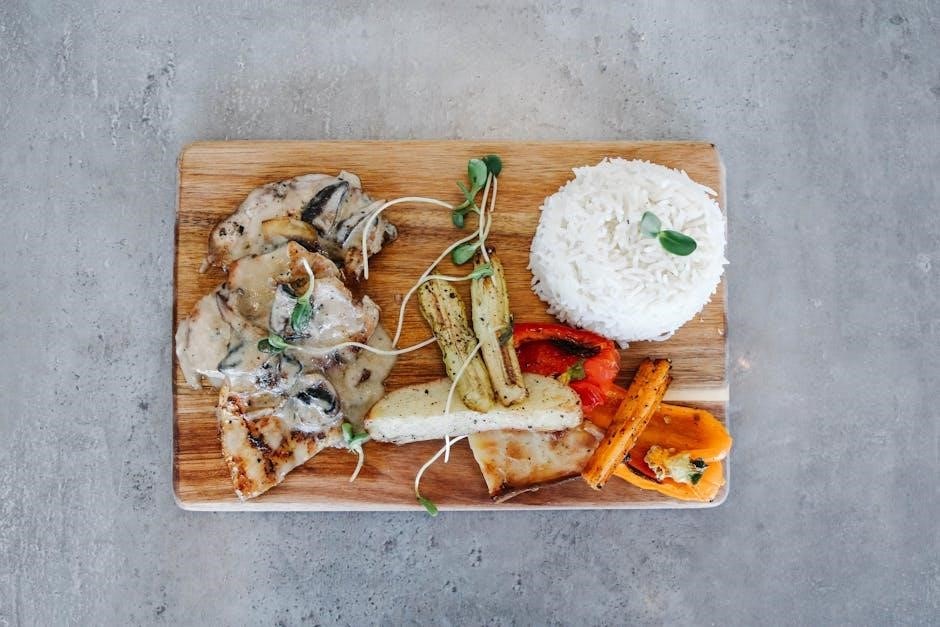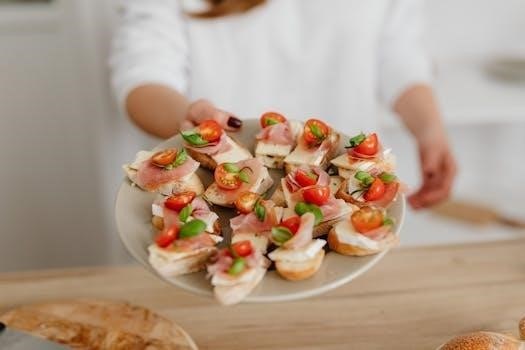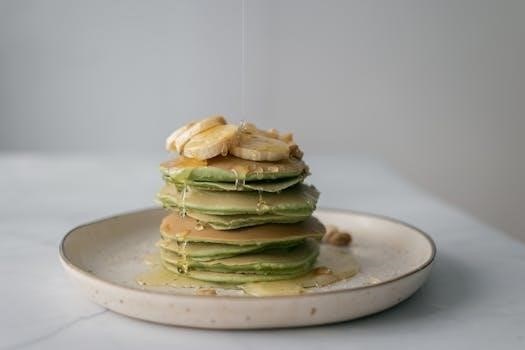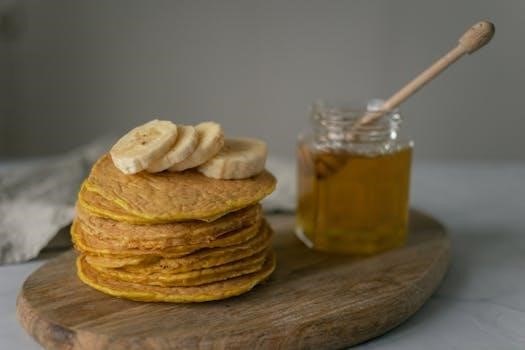Cooking brown rice in an Aroma rice cooker is simple and efficient, offering a healthy, flavorful meal. The cooker’s tailored settings ensure perfect results every time.
Overview of Brown Rice and Its Benefits
Brown rice is a whole grain, retaining its bran and germ, making it richer in nutrients compared to white rice. It is an excellent source of fiber, vitamins, and minerals like magnesium and manganese. Brown rice supports healthy digestion, helps regulate blood sugar levels, and provides sustained energy. Its higher fiber content also aids in satiety, making it a great choice for weight management. Additionally, brown rice contains antioxidants that promote overall health and reduce inflammation. It is versatile in both savory and sweet dishes, making it a nutritious and flavorful addition to meals. Cooking brown rice in an Aroma rice cooker ensures it is prepared to perfection, unlocking its full nutritional potential and delicious flavor.
Why Use an Aroma Rice Cooker for Brown Rice?
An Aroma rice cooker is ideal for cooking brown rice due to its tailored settings and user-friendly design. The cooker features a specific brown rice program, ensuring the grain is cooked to perfection with the right balance of moisture and heat. Its digital controls allow for precise cooking, automatically adjusting to the needs of brown rice, which requires a longer cooking time than white rice. The non-stick inner pot and even heat distribution prevent sticking and ensure fluffy results. Additionally, the cooker’s automatic shut-off and keep-warm functions make it convenient for hands-free cooking. These features make the Aroma rice cooker a reliable and efficient choice for preparing delicious and nutritious brown rice effortlessly.

Understanding the Aroma Rice Cooker
The Aroma rice cooker is a versatile kitchen appliance designed for easy, efficient rice preparation. Its digital controls, non-stick inner pot, and automatic shut-off ensure perfect cooking results.
Key Features of the Aroma Rice Cooker
The Aroma rice cooker boasts a user-friendly digital interface, non-stick inner pot, and automatic shut-off for convenient cooking. It features specialized programs like the Brown Rice function, ensuring optimal results. With a capacity of up to 8 cups, it accommodates various serving sizes. The cooker also includes a keep-warm feature, maintaining rice freshness post-cooking. Its compact design and easy-to-clean components make it a practical addition to any kitchen. The Aroma rice cooker is versatile, handling both white and brown rice effortlessly while ensuring consistent texture and flavor.
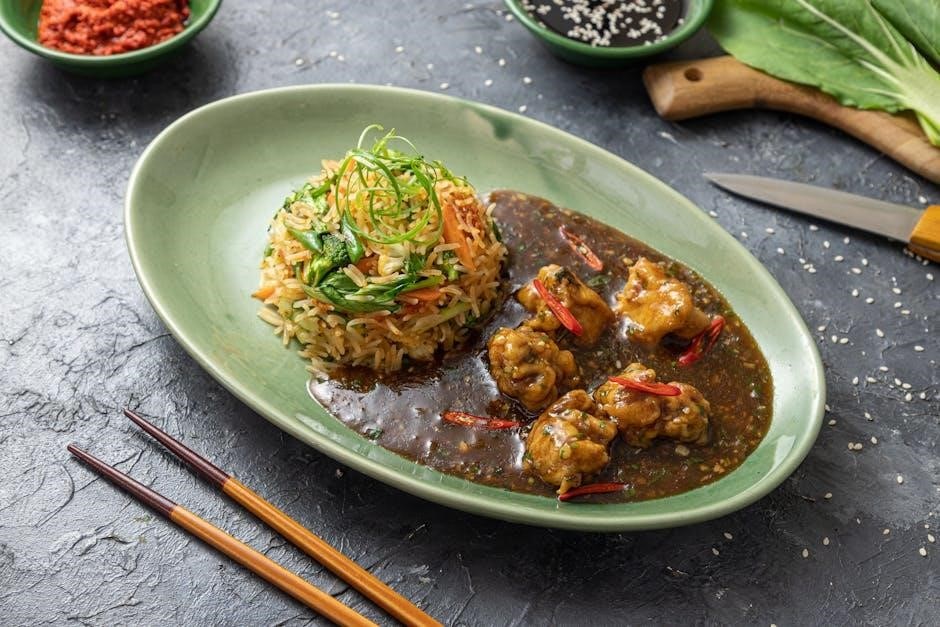
Brown Rice Cooking Function Explained
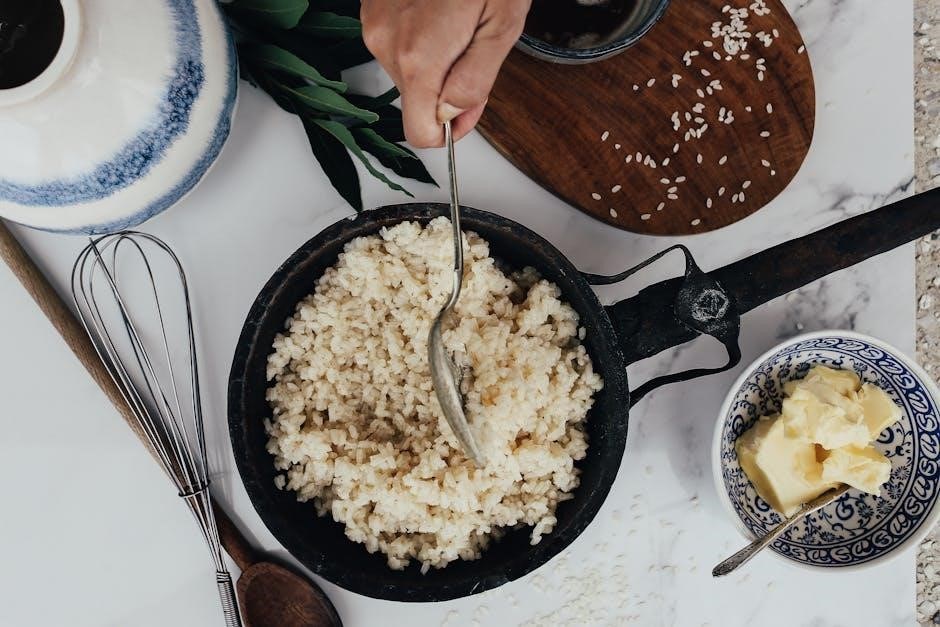
The Brown Rice function on the Aroma rice cooker is designed to handle the unique needs of cooking whole grain brown rice. This function uses extended cooking times and adjusted heat levels to ensure the rice is thoroughly cooked without becoming mushy. The cooker automatically adjusts the temperature during the cooking process, allowing the rice to simmer gently until it reaches the perfect texture. This specialized setting ensures that each grain is evenly cooked, resulting in a fluffy and nutritious meal. The Brown Rice function is a key feature that sets the Aroma rice cooker apart, making it ideal for health-conscious individuals who prefer brown rice.
Capacity and Yield: Brown Rice vs. White Rice
The Aroma rice cooker has a maximum capacity of 1 cup of uncooked brown rice, yielding approximately 2 cups of cooked rice. For white rice, the cooker can handle up to 2 cups of uncooked rice, resulting in about 4 cups of cooked rice. The difference in yield is due to the higher fiber and bran content in brown rice, which absorb more water during cooking. This capacity ensures that the cooker performs efficiently for both types of rice, providing consistent results. Understanding these measurements helps in planning meals and achieving the desired quantity of cooked rice for any recipe.

Preparation Steps for Cooking Brown Rice
Rinse brown rice thoroughly to remove impurities and excess starch. Measure rice and water using a 2:1 ratio. Add rinsed rice to the inner pot, ensuring proper preparation for cooking.
Measuring Rice and Water Ratios
For cooking brown rice in an Aroma rice cooker, the recommended ratio is 2 cups of water for every 1 cup of uncooked brown rice. This ensures the rice cooks evenly and retains its texture. To achieve the best results, use the measuring cup provided with the cooker. Some users suggest adding an extra 1/4 cup of water per cup of rice for fluffier grains. Always refer to the rice/water measurement guide included in the manual for precise instructions. Proper measurement is crucial to avoid undercooked or mushy rice. Ensure the water level aligns with the markings on the inner pot for consistent outcomes.
Rinsing Brown Rice: Why and How
Rinsing brown rice is essential to remove impurities, excess starch, and any debris. This step improves the texture and reduces the risk of a sticky or clumpy final product. To rinse, place the rice in a fine-mesh strainer and run cool water over it, gently swirling the rice with your hands. Repeat this process 3-4 times until the water runs clear. After rinsing, drain thoroughly and add the rice to the cooker. Proper rinsing ensures better flavor and a fluffier texture when cooked. This simple step is key to achieving perfectly cooked brown rice in your Aroma rice cooker.
Adding Rice to the Inner Pot
After rinsing, add the brown rice to the inner pot of your Aroma rice cooker. Ensure the rice is evenly spread across the bottom for consistent cooking. The maximum capacity for brown rice is typically 1 cup of uncooked rice, which yields 2 cups cooked. Avoid overfilling to prevent overflow during cooking. Once the rice is in place, you can add water according to the recommended ratio (2 cups water for 1 cup brown rice). For extra flavor, you can substitute water with broth or add seasonings. Secure the inner pot in the cooker and select the appropriate settings for brown rice. Avoid adding extra water beyond the ratio to ensure the rice cooks properly without becoming mushy.

Cooking Process
Select the brown rice program on your Aroma rice cooker for optimal results. The cooker adjusts heat and time automatically, ensuring perfectly cooked brown rice every time.
Selecting the Right Cooking Settings
Selecting the correct cooking settings is crucial for perfectly cooked brown rice. Use the brown rice program on your Aroma rice cooker, designed to handle the unique needs of whole grains. Ensure the water ratio is set to 2 cups of water for every 1 cup of uncooked brown rice, as recommended. Refer to the water level markings or manual for guidance. The cooker automatically adjusts heat and cooking time, eliminating guesswork. For precise results, avoid overfilling or using incorrect ratios. Once settings are selected, the cooker takes over, ensuring your brown rice is fluffy and evenly cooked without constant monitoring.
Using the Brown Rice Program
The Aroma rice cooker features a dedicated brown rice program designed to optimize cooking for whole grains. This program extends cooking time and adjusts heat levels to ensure brown rice is thoroughly cooked without becoming mushy. Simply measure the rice and water, add them to the inner pot, and select the brown rice setting. The cooker automatically manages the process, including a short soaking period and gradual temperature changes. Once cooking completes, the cooker switches to the keep-warm function, maintaining perfect texture and flavor. This program guarantees consistent results, making it easy to achieve fluffy, nutritious brown rice every time with minimal effort.
Understanding Water Levels for Brown Rice
Cooking brown rice requires precise water levels to achieve the perfect texture. The general recommendation is to use a 2:1 water-to-rice ratio for brown rice. However, the Aroma rice cooker’s inner pot has marked water lines, which are primarily designed for white rice. For brown rice, it’s best to refer to the rice/water measurement guide provided in the manual or use the measuring cup included with the cooker. Exceeding the recommended water level can result in a mushy texture, while too little water may leave the rice undercooked. The cooker’s brown rice program is calibrated to handle the extra water and longer cooking time required for whole grains, ensuring optimal results. Always measure carefully to avoid overfilling the pot and maintain the cooker’s performance.
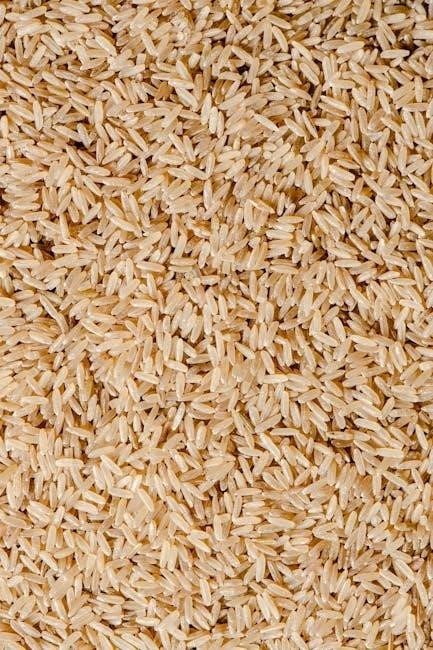
Cooking Brown Rice: Step-by-Step Guide
Place the inner pot in the cooker, close the lid, and press start. The cooker automatically handles cooking and shuts off when done, ensuring perfectly cooked brown rice.
Placing the Inner Pot in the Cooker
Position the inner pot carefully into the Aroma rice cooker, ensuring it aligns with the base and fits snugly. This step is crucial for even heat distribution and proper cooking. Once the pot is in place, add the measured brown rice and water, making sure not to exceed the recommended levels. Proper alignment prevents any movement during cooking, ensuring the rice cooks uniformly without interruption. Always refer to the manual for the correct positioning to avoid any issues during the cooking process.
Closing the Lid and Starting the Cooker
After placing the inner pot in the cooker, ensure the lid is securely closed to trap steam and promote even cooking. Align the lid properly with the cooker’s base to avoid any gaps. Once the lid is closed, locate the control panel and select the appropriate cooking setting, such as the Brown Rice program. Press the Start button to initiate the cooking process. The cooker will automatically manage the heat and timing, ensuring your brown rice is cooked to perfection. Avoid opening the lid during cooking, as this can disrupt the process. Once the cycle completes, the cooker will automatically shut off, signaling that your brown rice is ready.
Automatic Cooking and Shut-Off
The Aroma rice cooker is designed with advanced automation to simplify the cooking process. Once the Brown Rice program is selected and the Start button is pressed, the cooker takes over, carefully managing heat and timing to ensure perfectly cooked brown rice. The cooker is equipped with sensors that monitor the rice’s doneness and automatically adjust the cooking cycle. When the rice is fully cooked, the cooker will shut off on its own, eliminating the need for constant monitoring. This feature not only adds convenience but also prevents overcooking or burning. After cooking, the cooker switches to Keep Warm mode, maintaining the optimal temperature for serving. This automatic functionality ensures consistent results and hassle-free cooking every time.
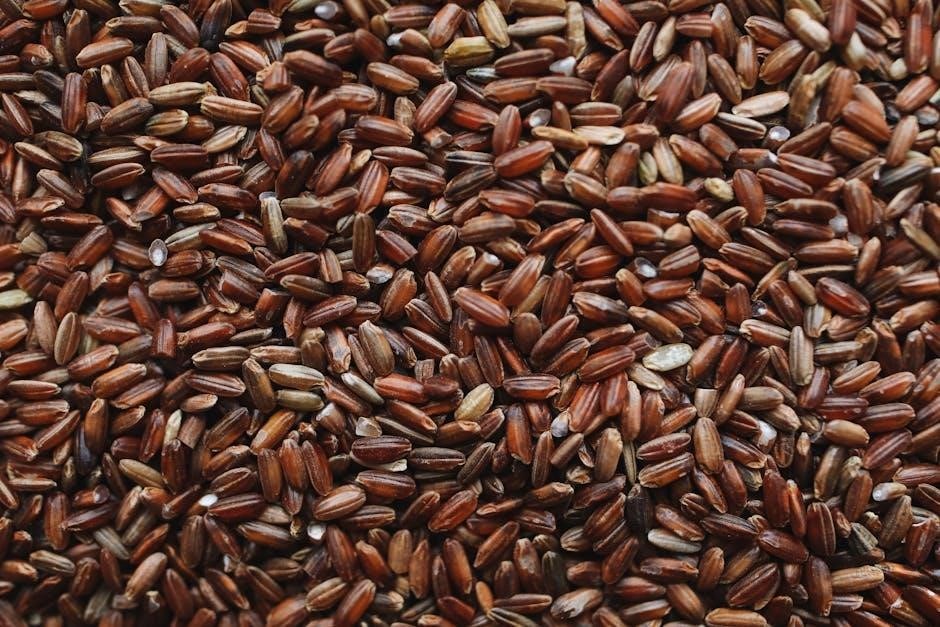
Post-Cooking Care
Post-cooking care involves fluffing brown rice with a fork, keeping it warm using the cooker’s Keep Warm function, and cleaning the pot thoroughly for maintenance. This ensures freshness and longevity of both the rice and the cooker.
Fluffing Brown Rice After Cooking
Fluffing brown rice after cooking is a crucial step to ensure it doesn’t stick together. Once cooked, use a fork to gently separate the grains, allowing steam to escape. This process helps distribute heat evenly and prevents clumping. Fluffing also enhances the texture, making the rice lighter and more palatable. It’s best to fluff while the rice is still warm but not hot, as this minimizes breaking the grains. Regular fluffing prevents the rice from becoming mushy and keeps it fresh for serving or storage. Proper fluffing ensures your brown rice remains fluffy and retains its natural nutty flavor and firm texture.
Keeping Rice Warm
After cooking, the Aroma rice cooker automatically switches to the “Keep Warm” function, maintaining the perfect temperature for serving. This feature ensures your brown rice stays warm and ready for up to 24 hours. To keep rice warm effectively, avoid opening the lid frequently, as this releases heat. If you won’t be serving immediately, fluff the rice gently with a fork to prevent clumping. The cooker’s insulation keeps the rice at a safe temperature, preventing bacterial growth. This convenient feature allows you to cook ahead and serve hot, fluffy brown rice whenever you’re ready. It’s ideal for meal prep or when coordinating multiple dishes for a meal.
Cleaning the Rice Cooker
Regular cleaning of your Aroma rice cooker ensures optimal performance and longevity. After cooking, unplug the cooker and let it cool slightly. Remove the inner pot and wash it with mild detergent and warm water. Avoid using abrasive cleaners or scourers, as they may damage the non-stick coating. Wipe the exterior with a damp cloth to remove any splatters or spills. The lid and other accessories can also be cleaned with soap and water. Ensure all parts are thoroughly dried to prevent moisture buildup. Cleaning the rice cooker regularly helps maintain hygiene and prevents rice residue from hardening. This simple maintenance routine keeps your cooker in great condition for future use.

Tips for Perfect Brown Rice
For ideal results, use a 2:1 water-to-rice ratio, rinse grains beforehand, and add flavor with broth or herbs. Use the brown rice program for best texture.
Adjusting Water Ratios for Desired Texture
For brown rice, the recommended water ratio is 2 cups of water for every 1 cup of uncooked rice. This ensures a tender yet firm texture. However, you can adjust the ratio slightly based on personal preference. If you prefer a softer texture, add a little more water, while less water will yield a firmer grain. Always refer to the measurement guide provided with your Aroma rice cooker, as some models may have specific water level indicators for brown rice. Adjusting the water ratio is key to achieving the perfect consistency every time.
Adding Flavor to Brown Rice
Enhance the taste of your brown rice by incorporating aromatic ingredients and seasonings. Start by sautéing garlic, onions, or shallots in a pan before adding them to the rice cooker. You can also mix in spices like cumin, turmeric, or paprika for a savory twist. For a fragrant option, add a bay leaf or a cinnamon stick to the inner pot. Additionally, consider using chicken or vegetable broth instead of water for added depth of flavor. A squeeze of fresh lime or lemon juice can brighten the dish, while a splash of coconut milk creates a creamy texture. Experiment with different combinations to find your favorite flavor profile and elevate your brown rice to the next level.
Troubleshooting Common Issues
Common issues when cooking brown rice in an Aroma rice cooker include undercooked or overcooked rice, rice sticking to the pot, or a crust forming at the bottom. If rice is undercooked, ensure the water ratio is correct (2:1 for brown rice) and check for proper lid sealing. Overcooked rice may result from excessive water or prolonged cooking; adjust the water ratio next time. To prevent sticking, lightly grease the inner pot with cooking spray. For crust formation, avoid overcrowding the cooker and stir the rice gently before serving. If issues persist, refer to the user manual or reset the cooker mid-cycle to adjust settings. Proper maintenance and adherence to guidelines will help achieve consistent results.

Cooking brown rice in an Aroma rice cooker is a convenient and healthy way to prepare a delicious meal, ensuring perfect texture and flavor every time.
Health Benefits of Brown Rice
Brown rice is a nutrient-rich whole grain, offering numerous health benefits. It is high in fiber, promoting digestion and satiety, while its B vitamins support energy production. Rich in minerals like magnesium and manganese, it aids bone health and metabolism. Brown rice contains antioxidants that combat oxidative stress, reducing inflammation. Its low glycemic index helps regulate blood sugar levels, making it ideal for diabetic diets. The bran layer in brown rice provides essential fatty acids and phytonutrients, supporting heart health and immune function. Incorporating brown rice into meals enhances overall nutrition, aiding in weight management and improving cholesterol levels. Its wholesome goodness makes it a superior choice over refined white rice.
Exploring Recipes with Cooked Brown Rice
Cooked brown rice serves as a versatile base for countless dishes, from hearty meals to light snacks. Add flavor by mixing in herbs, spices, or broth during cooking. Use it in stir-fries with vegetables and proteins, or as a filling for stuffed peppers. Brown rice salads, tossed with fresh veggies and a zesty dressing, make a nutritious lunch. It’s also a great addition to soups or casseroles for added texture. For breakfast, combine it with eggs, avocado, and salsa for a nutritious bowl. Experiment with seasonings like cumin or paprika to create unique flavor profiles. With its mild taste and hearty texture, brown rice opens the door to endless culinary creativity, ensuring meals are both satisfying and wholesome.
